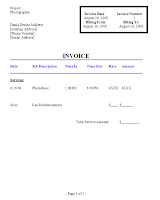 (This post will be more helpful for freelance models.)
(This post will be more helpful for freelance models.)Freelance modeling means that you not only act as your own agent and find your own work, you also have to deal with money and paperwork. While modeling agencies use vouchers in order to receive payment for their models and their company, freelance models can turn to a modeling invoice.
You can find samples of modeling invoices online (make sure it is for actual modeling and not product modeling or some other type of invoice) or you can create your own in Microsoft Word. The invoice does not have to snazzy or impressive--it simply serves the purpose of stating who is receiving payment, the hours worked, and the agreed upon rate.
The most important information to have on your modeling invoice is your full name (even if you use a model alias...you might want to add a line stating which is your legal full name and which is your model alias), your mailing address, contact number, email, the name of the shoot/project you worked for, the name of the client/company/photographer you worked with, the dates/times you worked, and the rate. Don't forget to add a line for the total amount. If there are any miscellaneous charges such as gas reimbursement, add that in as well.
Make sure that you keep a basic template of your modeling invoice that you can simply fill in each time and do a "Save As" so that you don't end up overwriting the template itself. This is much less of a hassle than having to create a brand new modeling invoice each time.
You may not be asked to provide an invoice for all freelance modeling jobs, but if so, make sure you know whether the client wants you to email it to them or bring it to the job on that day to fill out. If there is no mention of an invoice, you can ask if they would like you to have one. It never hurts to ask.
You will only use a modeling invoice if you are doing a modeling gig that is offering monetary compensation. TFPs and TFCDs and other "for trade" type of shoots will not need an invoice. Keep a copy of all invoices you use for future reference and for tax purposes.
I have attached a sample invoice with this post that I use for both my modeling and acting gigs. Feel free to copy it or do your own version.
Comments
HB Models
Please visit this link: http://amodelsdiary-readerquestions.blogspot.com/ and you can view your post there. Thanks for reading!
does this mean that i owe them money? or this is like a cheque ?
Please visit this link: http://amodelsdiary-readerquestions.blogspot.com/ and you can view your post there. Thanks for reading!